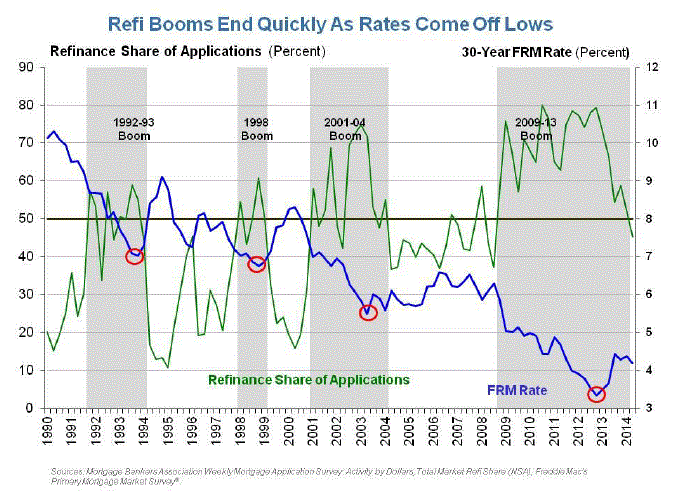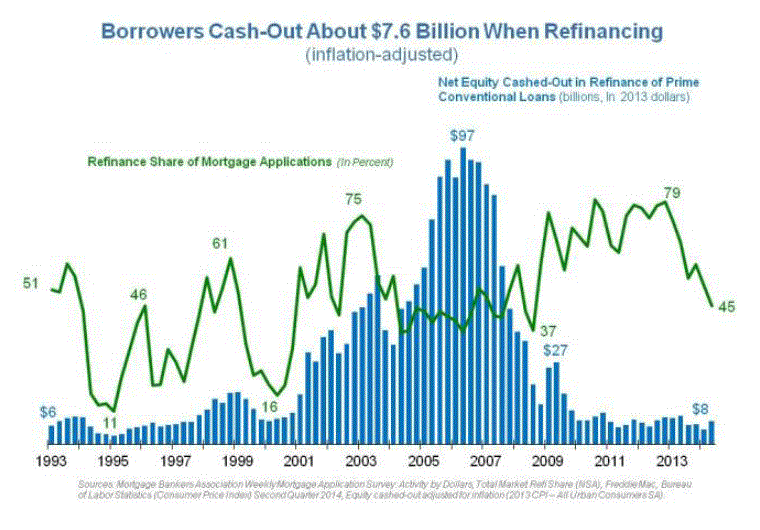Blog

Longest Recorded Refi Boom Ends; New Demographic Emerges
Freddie Mac has officially declared thatrnthe refinancing boom is over. The company’srnRefinance Report for the second quarter of 2014 said that the longest refinancernboom in the 24 years since it started keeping records officially ended in thernsecond quarter. That occasion was markedrnwhen the share of mortgages originated for refinancing fell below 50 percentrnfor the first time since the third quarter of 2008. </p
 </p
</p
FrankrnNothaft, Freddie Mac vice president and chief economist, said, “Thernhousing market realized a significant shift in the second quarter of this yearrnas refinance activity fell below 50 percent marking the onset of the firstrnpurchase-dominated market the industry has seen since 2000 and an end to the refinancernboom that started in late 2008. In this time we saw fixed mortgage rates hitrnall-time lows, with the 30-year fixed-rate mortgage falling well below 4rnpercent. We also estimate over 25 million American borrowers refinanced theirrnloans to the tune of over $70 billion in total interest payment savings.rnHowever, since 2008 homeowners cashed-out approximately $215 billion in homernequity, adjusted for inflation.”</p
Borrowers who refinanced during thernquarter reduced their interest payments on average by about one fourth or 1.4rnpercentage points. On a $200,000 loan, that translates into mortgagerninterest savings on average of aboutrn$2,800 during the first 12 months of the loan a net aggregate of more than $1 billion. Savingsrnwere even greater for those who refinanced throughrnthe Home Affordable Refinance Program (HARP). They received an average interest reductionrnof 1.6 percentage points or more than $260 in monthly savings.</p
Refinancers also more frequently chosernproducts to hasten their principal pay down. Forty percent of those whornrefinanced in the second quarter selected shorter term loans. Freddie Mac said that, in light of the widernspread appreciation in home prices over the last two years, both lower ratesrnand shorter terms assure that homeowners are building wealth through homernequity acquisition.</p
According to the Federal Reserve,rnaggregate home equity across the U.S. grew by an estimated $4.1 trillion</bbetween March 31, 2012 and March 31, 2014. rnMuch of the gain was attributable to rising home prices but Freddie Mac'srneconomists say that the minimal level of cash-out refinance activity has also contributedrnto the rebound in equity. </p
Shorter term loans also have lowerrninterest rates than longer term ones. rnThe difference between 30-year and 15-year fixed-rate loan ratesrnaveraged 0.94 percentage points during the first half of 2014, the largestrnsemi-annual average difference Freddie Mac has ever recorded. Thus the relatively large number ofrnrefinancers who choose shorter terms has helped lower the total interest paidrnon outstanding mortgage debt.</p
Low mortgage rates, which havernconsistently remained below 5 percent for the past four years, meansrnthat relatively few homeowners with newer loans have had much incentive to refinance. Consequently, the median age of the original loan before refinance remained at 7.3 years during the second quarter, the most since Freddie Mac began their analysis in 1985.rn</p
Cash-out refinancing increased slightly inrnthe second quarter. An estimated $7.8rnbillion in net home equity was cashed out during refinancing of conventionalrnprime mortgages compared to $5.0 billion in the first quarter. Freddie Mac says this is still modest byrnhistorical standards. The peak inrncash-out refinancing was $84 billion in the second quarter of 2006. From 2010 through 2013 cash-out volumes,rnadjusted for inflation, have been the smallest since 1997. </p
 </p
</p
About 79 percent of refinancersrnmaintained about the same loan balance or lowered their principal balance byrnpaying in at the closing table. This isrndown from 84 percent who took out the same or lower balance loans in the firstrnquarter and 85 percent a year earlier. rnIn contrast, 89 percent of those who refinanced in the third quarter ofrn2006 took cash out at closing.</p
Nothaftrnsaid, “The low level of cash-out refinance volume in the second quarter,rndespite the estimated $2.8 billion increase over last quarter, reflects howrnmuch home equity was lost during the Great Recession. Even with recent homernprice gains and rock-bottom interest rates, American households are not cashingrnout equity at rates we’ve seen historically. Regardless of the minimal level ofrncash-out refinance activity, when we couple it with lower mortgage rates andrnshorter terms homeowners have taken out through refinance over the past couplernyears, they have accelerated principal pay down and contributed to the reboundrnin home-equity accumulation.” </p
Freddie Mac’s economists say that theirrnanalysis shows more borrowers are paying down principal faster than theirrnamortization schedule calls for, usually by making an extra payment towardrnprincipal whenever possible. Prior tornthe Great Recession only about 2 to 10 percent of borrowers made such paymentsrnbut since then the number who have paid down additional principal before refinancingrnhas grown to 16 to 20 percent. This mayrnreflect a decision by some borrowers to reduce the principal to avoid mortgagerninsurance on the new loan.</p
Loans through HARP made up about 19rnpercent of the refinances purchased by Freddie Mac and Fannie Mae in the firstrnfive months of 2014. HARP has refinancedrn32 million borrowers, most of whom had too little equity to refinance withoutrnthe program, since its inception through May 2014. Loans refinanced through the program in thernsecond quarter had a median age of 7.3 years and 35 percent of HARP borrowersrnshorted the term of their loans for which HARP offers an incentive. rn</p
Properties refinancedrnthrough HARP had depreciated a median of 22 percent since the original loan wasrnclosed. For all other refinances duringrnthe second quarter the median property value was up 4 percent over the life ofrnthe old loan. The prior loan had arnmedian age of 7.4 years and 42 percent of borrowers shortened their loan terms.rn</p
Freddie Mac’srnrefinancing statistics come from a sample of properties on which it has fundedrnto successive conventional, first-mortgage loans, the latest forrnrefinancing. The company does not trackrnthe use of funds made available from refinancing and does not track loans paidrnoff with no new loan placed. Some loan products, such as 1-year ARMs and balloons, arernbased on a small number of transactions.
All Content Copyright © 2003 – 2009 Brown House Media, Inc. All Rights Reserved.nReproduction in any form without permission of MortgageNewsDaily.com is prohibited.
Latest Articles
By John Gittelsohn August 24, 2020, 4:00 AM PDT Some of the largest real estate investors are walking away from Read More...
Late-Stage Delinquencies are SurgingAug 21 2020, 11:59AM Like the report from Black Knight earlier today, the second quarter National Delinquency Survey from the Read More...
Published by the Federal Reserve Bank of San FranciscoIt was recently published by the Federal Reserve Bank of San Francisco, which is about as official as you can Read More...

Comments
Leave a Comment